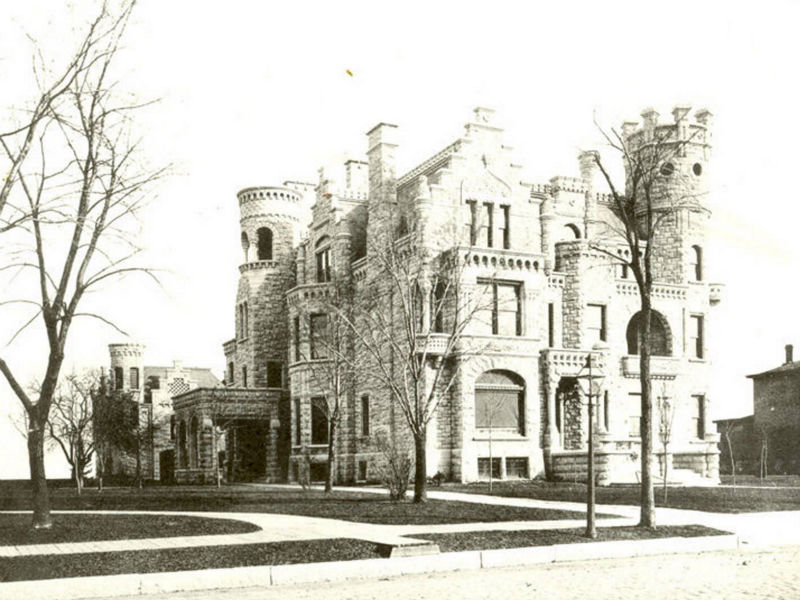During Doors Open Milwaukee last weekend, hundreds of visitors toured the Charles Allis Art Museum, one of many Gold Coast mansions that once lined Prospect Avenue from one end to the other. Only about a dozen of those historic mansions still remain today.
Although this district is listed on the National Register of Historic Places, the surviving landmarks are by no means permanently protected or preserved – as we were reminded again this summer.
In July, the Common Council rejected plans to incorporate the Goll House (1550 N. Prospect Ave.) into a 27-story apartment tower. Constructed in 1898 by merchant Frederick T. Goll (1854-1931,) the Elizabethan-style manor home was converted to rooming house use in 1936 and professional offices in 1950. After overlooking Lake Michigan for nearly 120 years, the Goll House now faces an uncertain future. Current owners lack the funds to restore the building; future buyers are likely to find the land more valuable without the mansion on it.
The Goll House’s conundrum is not a new one. On Feb. 4, 1963, two of its neighbors had their dates with destiny. Only one survived the encounter.
On that day, the Milwaukee Sentinel reported that two-time wealthy widow Mrs. Ragnar Hummel would bequeath her vacant 1923 mansion at 2220 N. Terrace Ave. for use as a public museum. Lloyd R. Smith, of A.O. Smith, built the Italian Renaissance home after an inspiring family vacation in Italy. Mrs. Hummel, his widow, was now living in New York City. With no need for Milwaukee real estate, she proposed the creation of a museum for Renaissance art.
Fifty years later, this distinctive mansion lives on as the otherworldly Villa Terrace Museum. Its contemporary, the David Benjamin mansion at 1570 N. Prospect Ave., was not quite so lucky.

Reading newspaper reports of the "Benjamin Castle," it’s hard to believe there was a time when such homes were common in Milwaukee.
With 13 balconies, an octagon turret, regal balustrades and an imposing Lannon stone face, the medieval castle and its adjoining coach house were built for lumber baron David Benjamin and his wife Annie in 1890. The first floor included a library, dining hall, sunroom and three parlors, with the second floor housing a billiard room, music room, grand ballroom and seven bedroom suites.
Annie, known for her striking snow-white hair, was the queen of Milwaukee high society for decades. Her art collection, including sculptures by Leonardo da Vinci, was considered one of the finest in North America.
The castle, considered one of the costliest and most extravagant ever built in Milwaukee, became such a landmark that it was regularly featured on picture postcards sent back to Europe. The scene was described as a "Rhine River castle, transported to this German Athens." Benjamin Castle was the perfect architectural complement to its neighbor, the Charles McIntosh mansion (1584 N. Prospect Ave.), today’s Wisconsin Conservatory of Music.
David Benjamin only lived two years in the home before dying in 1892. When Annie died on March 7, 1938, she left the Milwaukee mansion, a sprawling Gulf Coast estate and a $2.2 million fortune to her two children.
"Benjamin Castle, which with its old world turrets has guarded the lake bluff for nearly a half century, is without a mistress," reported the Milwaukee Sentinel. "In recent years, the castle was entered by few outsiders, as the elderly widow withdrew into seclusion."
Son Fred Benjamin lived alone in the mansion until his death in 1945. His sister, Catherine Benjamin Lindsay, later founded the village of River Hills. Most of the family’s art collection was sold before Catherine’s death in 1958.
From 1945 to 1963, Benjamin Castle was transformed into "Shore View," a convalescent home for seniors. On Feb. 4, 1963, the mansion’s demolition began, and the "modern" 125-unit Harborside Apartments replaced it a year later.
If Benjamin Castle had survived the 1960s, it may still be with us today as a spectacular tribute to the past in our present. It’s not exactly clear why the building was demolished. Judging from news photos, the home was as architecturally sound in 1963 as it was in 1890. True, the interior had been stripped of most of its grandeur, but the exterior was in gorgeous condition.
Like many other irreplaceable Prospect Avenue mansions, Benjamin Castle was a faded Victorian memory in a time that only cared about the future. Sadly, it seems to have been torn down simply because it was old and in the way.
Watching the sunset illuminate the face of the Goll House, one hopes that Milwaukee won’t make the same mistakes again.







